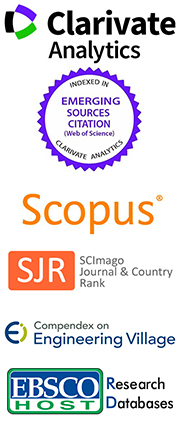Application of Green Roof Landscape Design Incorporating Building Energy Efficiency Concepts and Analysis of Urban Thermal Efficiency Benefits
Abstract
Keywords
Full Text:
PDFReferences
Law C.M.Y., Hui L.C., Jim C.Y. and Ma T.L., 2021. Tree species composition, growing space and management in Hong Kong's commercial sky gardens. Urban Forestry and Urban Greening 64(4): 127267.1-127267.11.
Maltseva I.N., Shvalev D.M. and Tkachuk K.A., 2021. Problems and solutions for green roofs. IOP Conference Series: Materials Science and Engineering 1066(1): 12012-12021.
Saracoglu O.A., Cakar H., Akat H., and Adanacioglu H., 2022. Performance analysis of different geotextile materials in extensive roof garden designs. Journal of Environmental Engineering and Landscape Management: International Research towards Sustainability 30(4): 484-492.
Usman A.M. and M.K. Abdullah. 2023. An assessment of building energy consumption characteristics using analytical energy and carbon footprint assessment model. Green and Low-Carbon Economy 1(1): 28-40.
Jamei E., Thirunavukkarasu G., Chau H.W., Seyedmahmoudian M, Stojcevski A., and Mekhilef S. 2023. Investigating the cooling effect of a green roof in Melbourne. Building and Environment 246(12): 1.1-1.21.
Rabbani M. and F. Kazemi. 2022. Water need and water use efficiency of two plant species in soil-containing and soilless substrates under green roof conditions. Journal of Environmental Management 302(Pt A): 113950-113967.
Liu J., Liu P., Wang X., Liu S., Wang G., and Shuang W.U., 2021. Design and construction of sponge city facilities in Changzhen depot of Shenzhen metro. Journal of Shenzhen University Science and Engineering 38(1): 20-26.
Akar H., Saracoglu O.A., Akat H., Kl C. and Adanacolu H., 2023. The potential for using different substrates in green roofs. Journal of Environmental Engineering and Landscape Management 31(1): 44-51.
Gohari A., Gohari A., and Ahmad A. B., 2023. Importance of green roof criteria for residential and governmental buildings: A multi-criteria decision analysis. Environmental Science and Pollution Research 30(2), 3707-3725.
Durdyev S., Koc K., Karaca F., and Gurgun A.P., 2023. Strategies for implementation of green roofs in developing countries. Engineering, Construction and Architectural Management 30(6), 2481-2502.
Bortolini L. and V. Brasola. 2022. Simulating the impact of nature-based solutions on runoff control by using i-Tree Hydro: a case study in Padua (Italy). Acta Horticulturae 1345(47): 351-358.
Semeraro T., Scarano A., Buccolieri R., Santino A., and Aarrevaara E., 2021. Planning of urban green spaces: An ecological perspective on human benefits. Land 10(2): 1-26.
Reichelstein S., 2024. Corporate carbon accounting: balance sheets and flow statements. Review of Accounting Studies 29(3): 2125-2156.
Piatka D.R., Frank A.H., and Koehler I., 2022. Balance of carbon species combined with stable isotope ratios show critical switch towards bicarbonate uptake during cyanobacteria blooms. Science of the Total Environment 803(3): 1-13.
Pamponet M.C., Maranduba H.L., Neto J.A.A., and Rodrigues L.B., 2022. Energy balance and carbon footprint of very large‐scale photovoltaic power plant. International Journal of Energy Research 46(5): 6901-6918.
Lai Q., Zheng H., Tang Z., Bi D., Chen N., and Liu, X., 2021. Balance of N-doping engineering and carbon chemistry to expose edge graphitic N sites for enhanced oxygen reduction electrocatalysis. ACS Applied Materials and Interfaces 51(13): 61129-61138.
Li X., Wang Y., Wu K., and Feng Z., 2023. Analysis and prediction of carbon balance in production-living-ecological space of Henan Province, China. Environmental Science and Pollution Research 30(30): 75973-75988.
Ran L., Wang X., Li S., Zhou Y., Xu Y. Chan C.N., Fang N., Xin Z., and Shen H., 2022. Integrating aquatic and terrestrial carbon fluxes to assess the net landscape carbon balance of a highly erodible semiarid catchment. Journal of Geophysical Research Biogeosciences 127(3): 1-15.
Yu Z., Liu Z., Chen M., Zhao J., Hao C., Zhang Y., and Li X., 2023. Optimizing charge balance in carbon dot-based LEDs for enhanced performance. Journal of Materials Chemistry C 11(46): 16280-16287.
Yuan Z., Zhen Y., Juan Z., and Wenjie Z., 2023. Study on the initial carbon quota allocation and spatial balance compensation strategy at the provincial level in China. Environmental Science and Pollution Research 30(25): 67150-67171.
Ester G.D.A., Gazol A., and Ignacio Querejeta J., 2022. The role of nutritional impairment in carbon-water balance of silver fir drought-induced dieback. Global Change Biology 28(14): 4439-4458.
Ejarque E., Scholz K., Wohlfahrt G., Battin T.J., Kainz M.J., and Schelker J., 2021. Hydrology controls the carbon mass balance of a mountain lake in the eastern European Alps. Limnology and Oceanography 66(6): 2110-2125.
DOI: https://doi.org/10.64289/iej.25.0309.4933650


